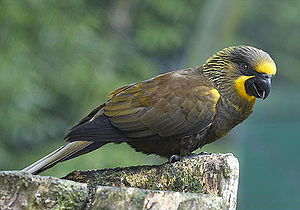Brown Lorikeet
| Brown Lorikeet | ||||||||||||
|---|---|---|---|---|---|---|---|---|---|---|---|---|

Brown Lorikeet ( Chalcopsitta duivenbodei ) |
||||||||||||
| Systematics | ||||||||||||
|
||||||||||||
| Scientific name | ||||||||||||
| Chalcopsitta duivenbodei | ||||||||||||
| ( Dubois , 1884) |
The Brown Lory ( Chalcopsitta duivenbodei ) is a nectar drinking species of the genus chalcopsitta ( Chalcopsitta ).
features
This rare species reaches a height of about 31 cm and a weight of 200 to 230 g. The coloration varies somewhat depending on the subspecies. The basic color is dark olive brown. Body parts such as chin, forehead, cheeks, wing bend, thighs and under wing coverts are colored golden yellow, which turns into black. The dark circles and the beak , as well as the feet are matt black. The reins, wax skin and the area around the beak are not feathered. The iris is colored orange-red. Young animals have even darker colors and a darker iris.
The subspecies C. d. Described by Oscar Neumann in 1915 . syringanuchalis , which he named in honor of Neumann's Brown Lorikeet, has a darker brown on the head and back, which in many specimens has a dark purple tinge.
distribution and habitat
The Brown Lorikeet is found in a strip near the coast in northern New Guinea . While the nominate form C. d. duivenbodei occurs west of Geelvink Bay in western New Guinea to the area around Aitape in the province of Sandaun (formerly Westsepik) in Papua New Guinea , east from Ataipe to Astrolabe Bay the distribution area of C. d. syringanuchalis .
Its habitat is the dense tropical rainforest up to a height of 200 m.
Way of life
Behavior and nutrition
The diurnal birds live together in pairs or smaller groups of around 10 to 15 animals.
As with all Loris , food is taken up by a long, narrow tongue, the tip of which is densely covered with papillae. The main food in nature is nectar, fruits and pollen. With their long and rather delicate beak, they are adapted to this special food.
Reproduction
The exact breeding season of the Brown Lorikeet is unknown, but breeding usually begins in March. The normal clutch consists of two to four eggs and the incubation period is 24 to 26 days. The young leave the nest after 10 to 11 weeks. Two broods per year are possible.
Keeping as an ornamental bird

They are very noisy parrots that stand out for their liveliness. Like all parrots, they need to be given some time initially as they are still a bit suspicious. Later, they are very trusting and not very shy birds, which after the acclimatization period are insensitive and easy to care for. Brown loris like to be sprinkled with water and like to bathe extensively. It is recommended to keep the birds in an outdoor aviary with a heated shelter, as they give off very liquid droppings and need a lot of space. A porridge made from fruit, bee pollen, brewer's yeast, rice flakes, 7-grain flakes, grape sugar and skimmed milk yoghurt is served as feed. In addition, fresh branches with buds and leaves are to be offered.
Danger
The Brown Lorikeet has been listed as a species to be protected since June 6, 1981 in Appendix II of the Washington Convention on Species Protection . These and other measures led to stable populations, so that the species is classified as Least Concern on the IUCN Red List .
Web links
- www.tierportraet.ch - about the Brown Lorikeet
Individual evidence
- ↑ a b c Joseph M. Forshaw , illustrated by William T. Cooper: Australian Parrots. 1st German-language edition. Volume 1: Cockatoos and Lories. Arndt-Verlag, Bretten 2003, ISBN 978-3-9808245-1-4 .
- ↑ a b c Papageien.de : Profile of the Brown Lorikeet ( Memento of the original from September 11, 2014 in the Internet Archive ) Info: The archive link was inserted automatically and has not yet been checked. Please check the original and archive link according to the instructions and then remove this notice.
- ↑ a b Parrot Breeding Karl: Braunlories
- ↑ a b Parrot Network Working Group: Chalcopsitta duivenbodei
- ↑ Chalcopsitta duivenbodei in the endangered Red List species the IUCN 2011. Posted by: BirdLife International, 2009. Accessed November 14, 2011th
